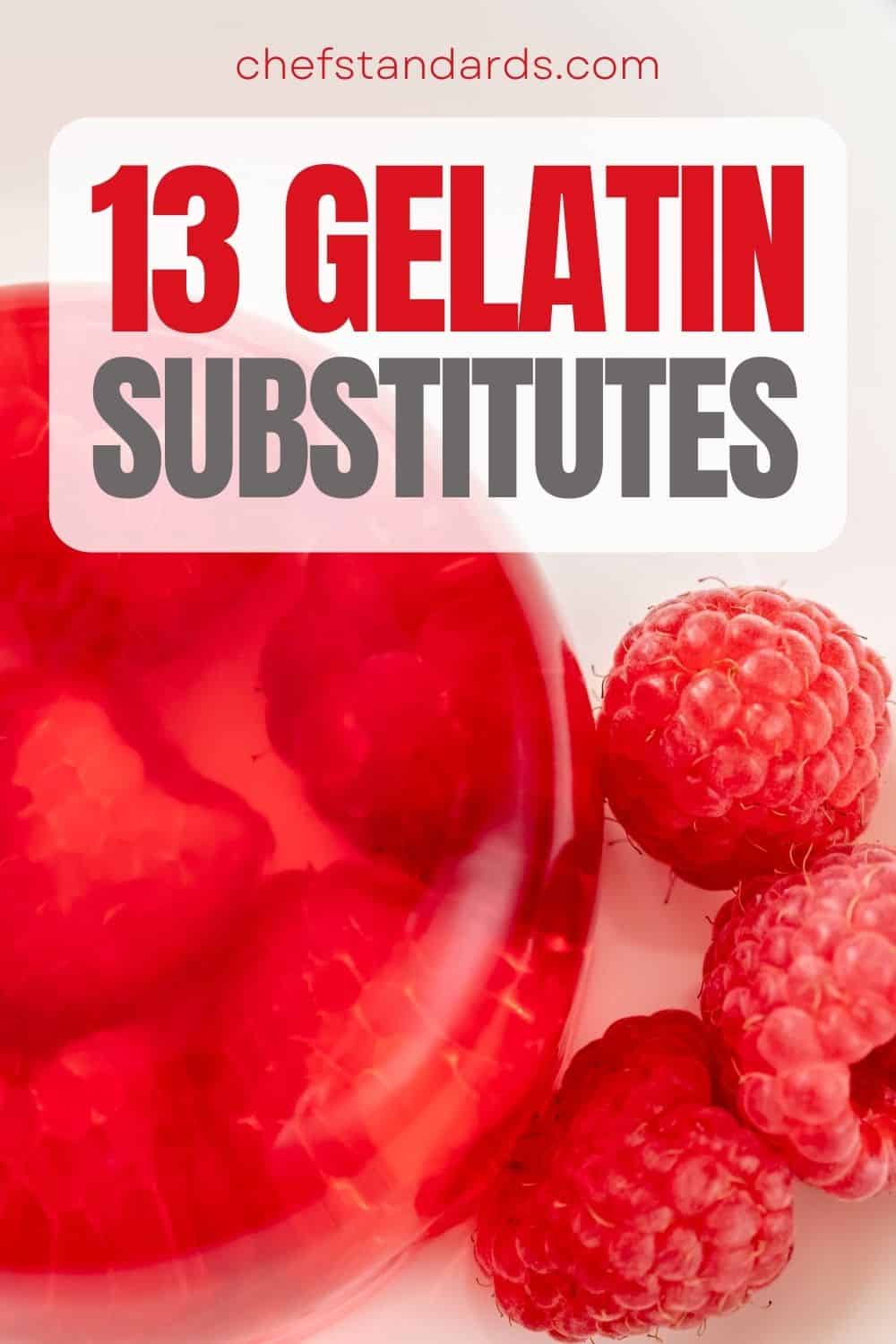Except for being delicious, gummy bears, mouse cakes, panna cotta, and marshmallows all have one thing in common: GELATIN. Let’s say that you’re in the mood to cook one of these (or similar recipes) but you don’t have any gelatin at hand.
Finding the best replacement for gelatin is not an easy task. It took me a while to figure out the best possible gelatin substitutes that I can use in almost any baking recipe.
Well, in order to find the best substitute for gelatin, you need to understand its characteristics.
Here are the main gelatin specifications:
• Color: colorless (transparent)
• Flavor: flavorless
• Odor: odorless
• Made from: clear protein from cows or pigs
• Texture: gel-like or thickened
• Solubility: soluble in warm water
• Two forms of gelatin: gelatin strips and gelatin powder (can be used interchangeably).
To help you find the best substitute, I’ll compare each gelatin substitute to gelatin in terms of their similarities and differences.
NOTE: Most of the gelatin substitutes on the list are suitable for vegans and vegetarians.
Substitutes For Gel-Like Texture
If you want to achieve that gel-like consistency in your recipes, then these substitutes are what you’re looking for. NOTE: You can also use some of these substitutes as thickening agents as well.
1. Agar agar
If you’re looking for one of the best substitutes for gelatin, then agar agar should be your first choice.
Similarities
• Color: Both agar agar and gelatin are colorless (transparent) but you can add colors to them.
• Flavor: Both agar agar and gelatin are flavorless.
• Odor: Agar agar and gelatin don’t have any odor.
• Texture: Both agar agar and gelatin can be used for gel-like texture or as thickening agents.
• Solubility: Agar agar and gelatin are soluble in warm water.
• Availability: Both agar agar and gelatin are widely available in supermarkets, grocery stores, and online shopping sites.
Differences
• Made from: Agar agar is made from red algae which is a type of seaweed, while gelatin is made from clear protein from cows or pigs.
• Forms: Agar agar comes in strips, flakes, and powder form, whereas gelatin comes in strips and powder form.
• Price: Agar agar is more expensive than gelatin. The prices for each form are shown in the table below:
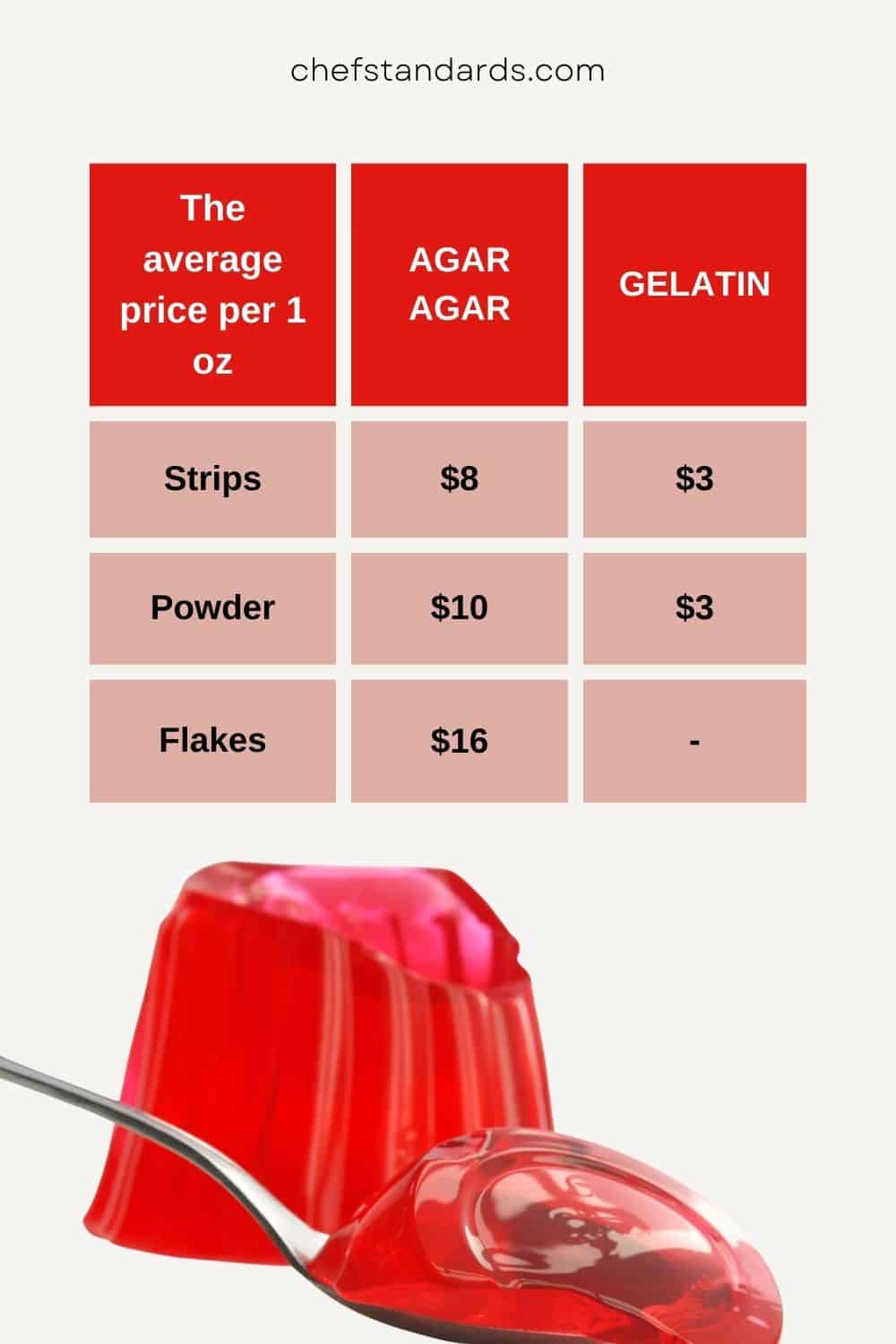
How to use agar agar in recipes
Substitute ratio: Keep in mind that agar agar is more potent than gelatin which means you need to use fewer amounts of it for the same effect. 1 teaspoon of agar per 1 liter of liquid is what works for me.
Preparation: Mix agar agar with water and bring it to a simmer for 1 to 2 minutes. Whisk vigorously to achieve the desired gel-like consistency.
Recipes: Agar agar is mostly used for panna cotta and mouse cakes.
2. Pectin
Good old pectin! This substitute is derived from fruit and it provides a perfect gel-like texture.
Similarities
• Color: Both pectin and gelatin are colorless (transparent) but you can add colors to them.
• Flavor: Pectin and gelatin are flavorless.
• Solubility: Both pectin and gelatin are soluble in warm water.
• Odor: Pectin and gelatin are odorless.
• Texture: Pectin and gelatin share a gel-like texture.
• Availability: Both pectin and gelatin are widely available in supermarkets, grocery stores, and online shopping sites.
Differences
• Made from: Pectin is made from fruit, whereas gelatin is made from clear protein from cows or pigs.
• Forms: Pectin comes in liquid and powder form, while gelatin comes in strips and powder form.
• Price: Pectin and gelatin have a similar price for powder form. See the table below:
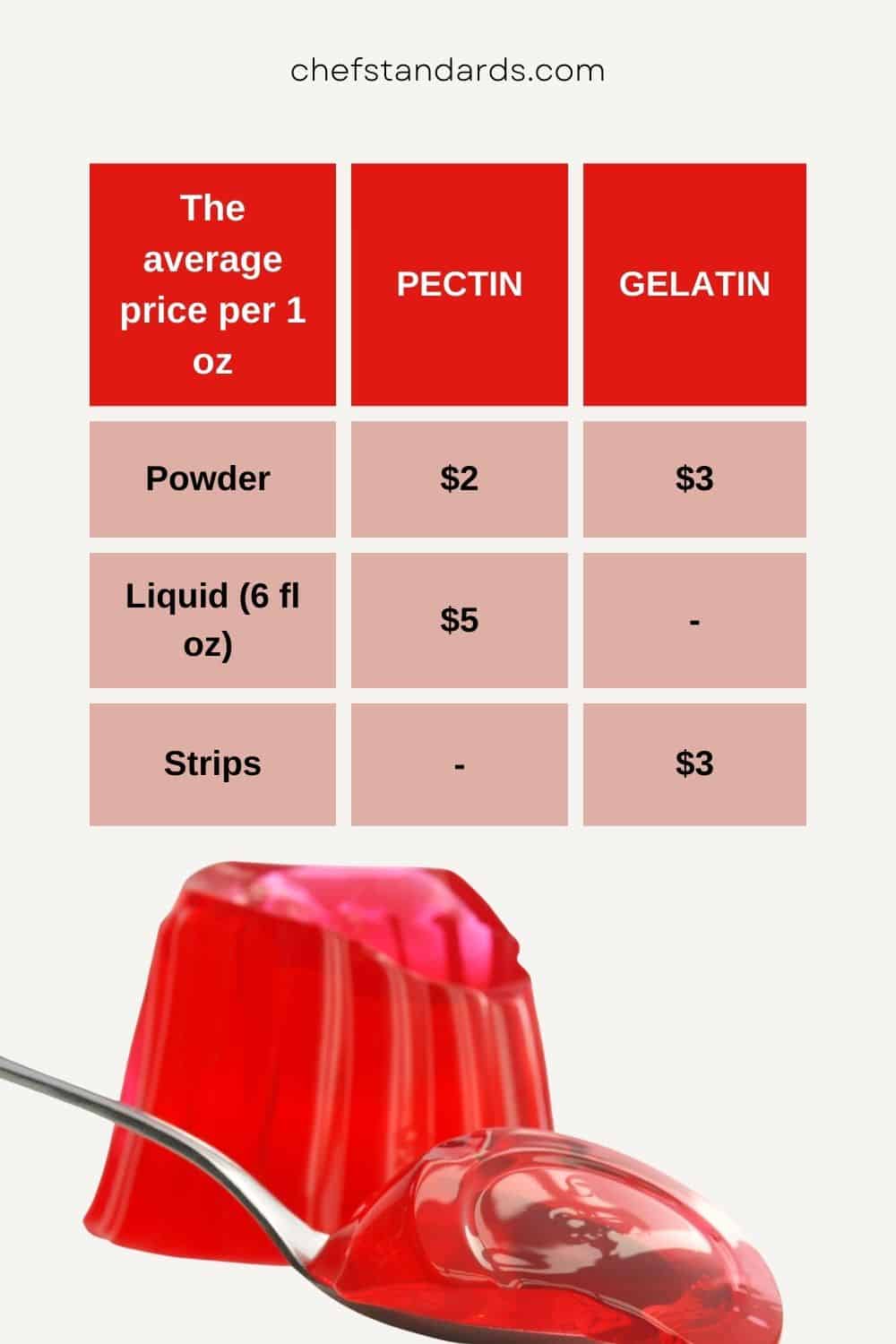
How to use pectin in recipes
Substitute ratio: There’s no recommended substitute ratio. Feel free to experiment with it.
Preparation: Mix pectin with sugar first and then dissolve it in lukewarm water before adding to the rest of the ingredients.
Recipes: Pectin is most commonly used for jams, jellies, marmalades, and jelly toppings for cakes.
3. Vegan Jel
After agar agar, Vegan Jel is my second favorite gelatin substitute because it has the same gel-like form as gelatin.
Similarities
• Odor: Vegan Jel and gelatin don’t have any odor. However, Vegan Jel may contain a subtle odor of natural ingredients (colors) that are added to it.
• Texture: Both Vegan Jel and gelatin can be used for gel-like texture or as thickening agents.
• Solubility: Vegan Jel and gelatin are soluble in warm water.
• Availability: Both Vegan Jel and gelatin are widely available in supermarkets, grocery stores, and online shopping sites.
Differences
• Made from: Vegan Jel is usually made of several ingredients: vegetable gum, citric acid, tapioca dextrin, calcium phosphate, and potassium citrate. Contrary to it, gelatin is made from clear protein from cows or pigs.
• Flavor: Vegan Jel comes in both flavorless and natural flavor-added versions. The most common flavors used are strawberry, peach, black cherry, orange, raspberry, and lime. Gelatin is flavorless.
• Forms: Vegan Jel comes only in powder form, while gelatin comes in strips and powder form.
• Color: Vegan Jel comes in both colorless and colored versions depending on the color of the natural ingredient used. Gelatin is colorless but you can also add colors to it.
• Price: Vegan Jel is slightly more expensive than gelatin. See the table below:

How to use Vegan Jel in recipes
Substitute ratio: You can substitute gelatin with Vegan Jel at a 1:1 ratio. In other words, add the same amount of Vegan Jel to your recipes as you would add gelatin.
Preparation: Mix the powder with water and bring it to a boil. Add the Vegan Jel to your dessert and place it in the fridge to cool for a gel-like consistency.
Recipes: Vegan Jel is mainly used for marshmallows, jello shots, and other jello-based desserts.
Substitutes For Thickening Needs
These substitutes will not give you that harder, stiffer gel-like texture but you can use them as thickening agents in your recipes. Here’s how these alternatives compare to gelatin.
1. Xanthan gum
Xanthan gum is one of the most commonly used food additives for thickening purposes or as a stabilizer.

How to use xanthan gum in recipes
Substitute ratio: Add the same amount of xanthan gum powder as you would add gelatin powder to your recipe.
Preparation: Add xanthan gum directly into the liquid you’d want to thicken. It doesn’t need to be mixed with warm water to dissolve.
Recipes: Xanthan gum is commonly used in soups, ice cream, sauces, salad dressings, gluten-free cakes, bread, muffins, syrups, etc.
See Also: 15 Best Xanthan Gum Substitutes For Your Ideal Baked Dish
2. Cornstarch
Another famous thickening agent in my kitchen is cornstarch which I’ve been using in almost every recipe that requires thickening. However, that is just one of many reasons why people use cornstarch.
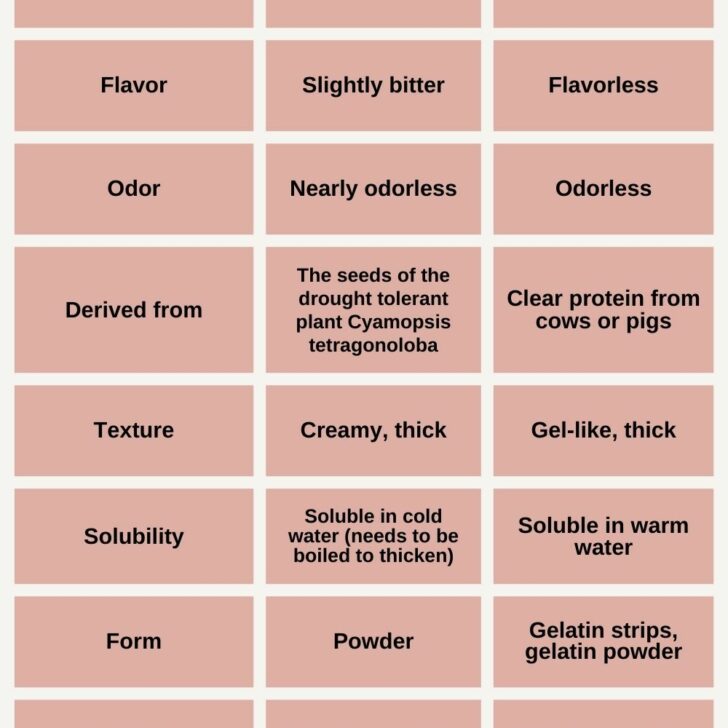
How to use cornstarch in recipes
Substitute ratio: There’s no recommended substitute ratio.
Preparation: Mix a 1:1 water ratio with cornstarch and bring it to a boil for 1 to 2 minutes for it to thicken.
Recipes: Cornstarch is commonly used in marmalade, jam, cheesecake, and sweet and savory sauces.
3. Guar gum
Guar gum is an excellent vegetarian or vegan option that can be used in almost any recipe. Here’s how guar gum compares to gelatin.
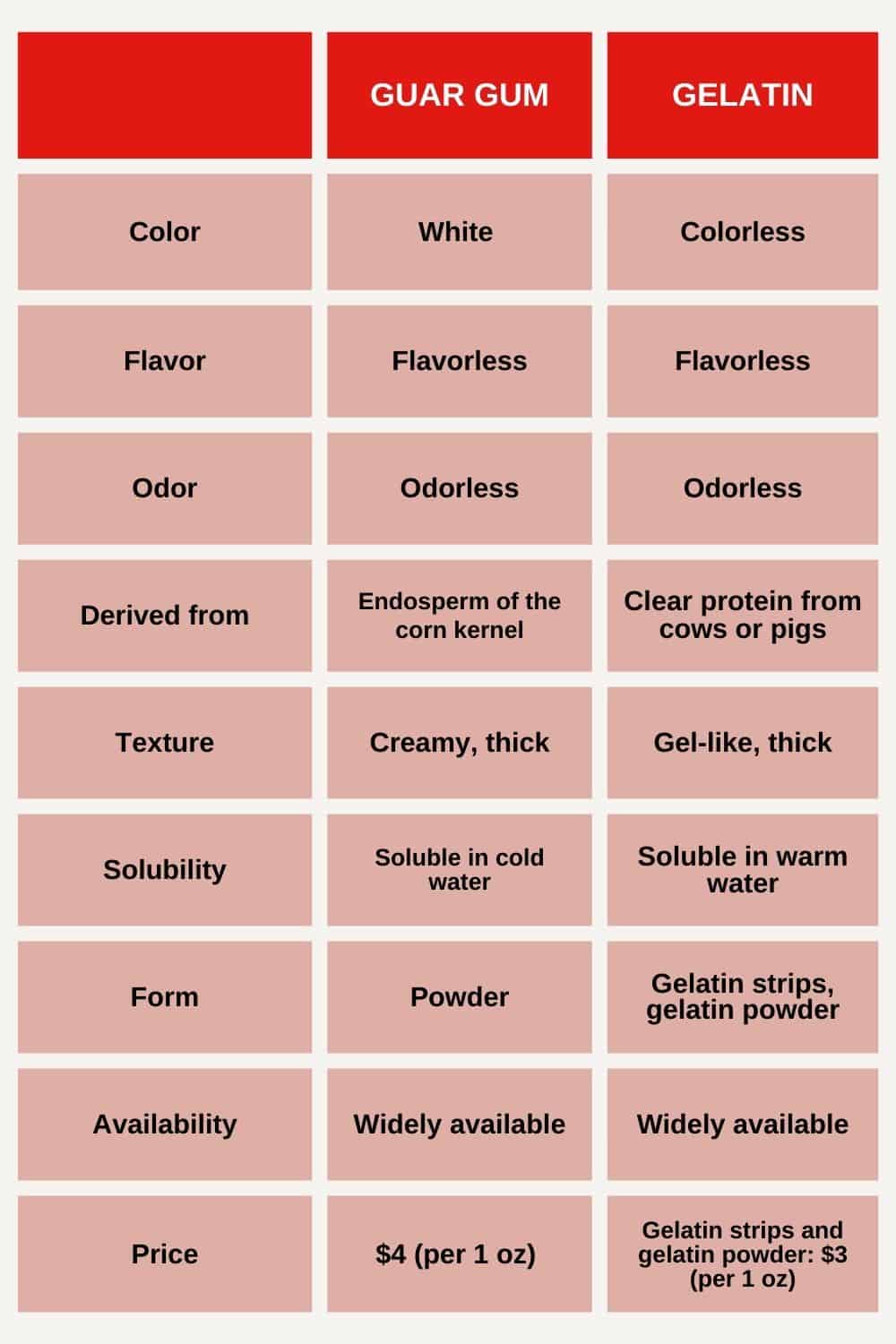
How to use guar gum in recipes
Substitute ratio: Use equal amounts of guar gum as you would use gelatin powder.
Preparation: You don’t need to use heat to activate guar gum. Simply add it to the dry ingredients and then mix it with the liquid ingredients.
Recipes: Guar gum can be used for jellies, ice cream, custards, sauces, gluten-free cookies, cakes, and many more.
4. Tapioca starch
If you ask me, tapioca starch is another wonderful thickening agent every kitchen should have.
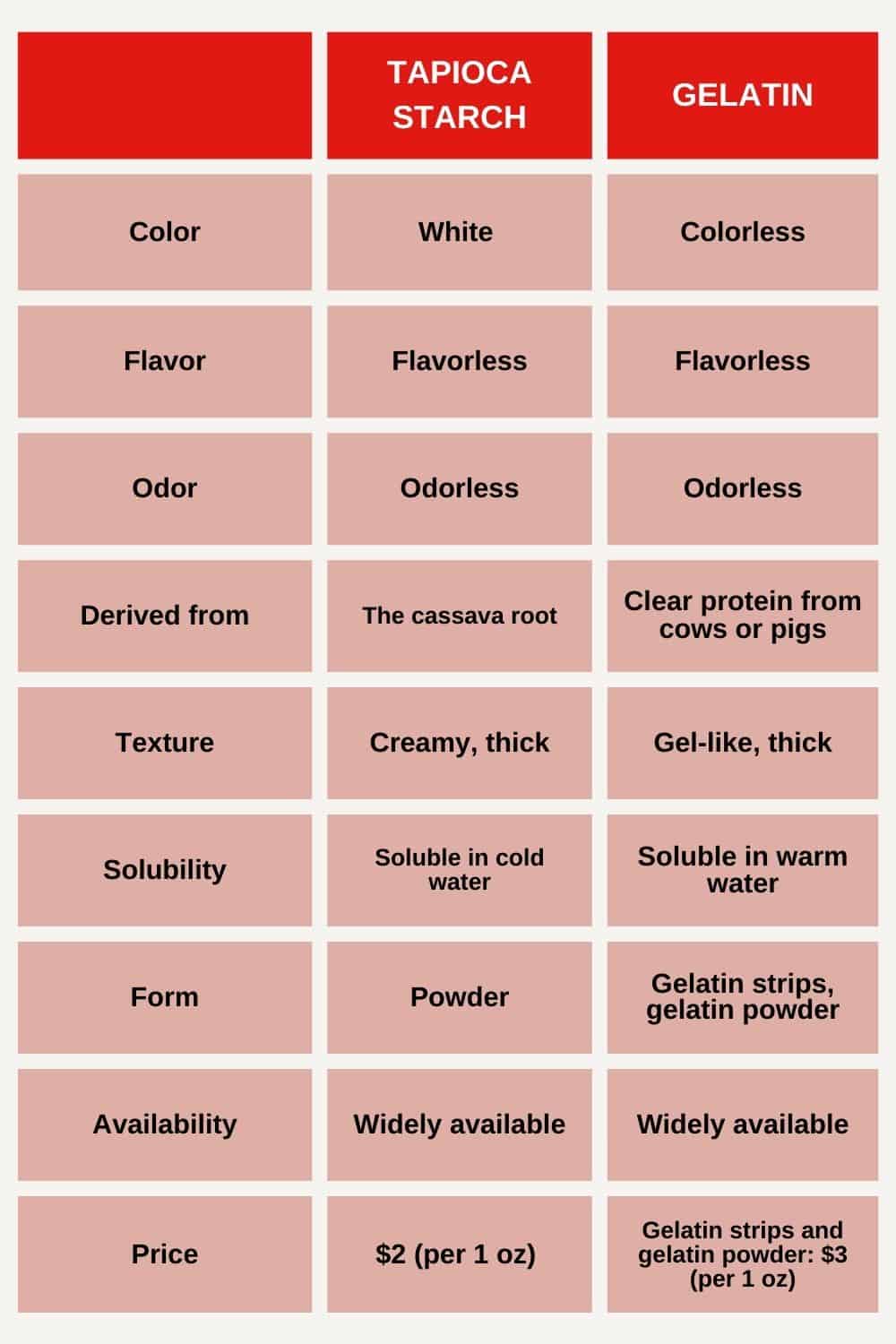
How to use tapioca starch in recipes
Substitute ratio: Add 2 teaspoons of tapioca starch for 1 ¼ teaspoon of gelatin powder.
Preparation: Mix the tapioca starch with the dry ingredients for oven-baked recipes. Or you can mix it with liquid for sauces and soups.
Recipes: Tapioca starch is most commonly used for sauces and jelly.
5. Carrageenan
Made from Irish Moss, Carrageenan will help you thicken any dish you want for a bit higher price than gelatin.

How to use carrageenan in recipes
Substitute ratio: There’s no strict substitute ratio. Feel free to experiment with it.
Preparation: Mix it with the liquid you’d like to thicken and whisk.
Recipes: Use Carrageenan for ice cream, pudding, creamers, mousses, soups, and plant-based cheeses.
6. Kudzu
Kudzu starch is traditionally used to make Japanese sweets. The average price per 1 oz is much higher than that of gelatin but if you ask me, it’s totally worth it!

How to use kudzu in recipes
Substitute ratio: Add 1 ½ tablespoons of kudzu per 1 cup of water.
Preparation: Mix it with the liquid you’d like to thicken and whisk.
Recipes: Use kudzu for savory sauces, cold custard fillings, or chocolate pudding.
7. Instant clear gel
Instant clear gel is similar to Vegan Jel but it’s not the same thing. The main difference is that Vegan Jel is suitable for both gel-like texture and thickening, while the instant clear gel is used only as a thickening agent.
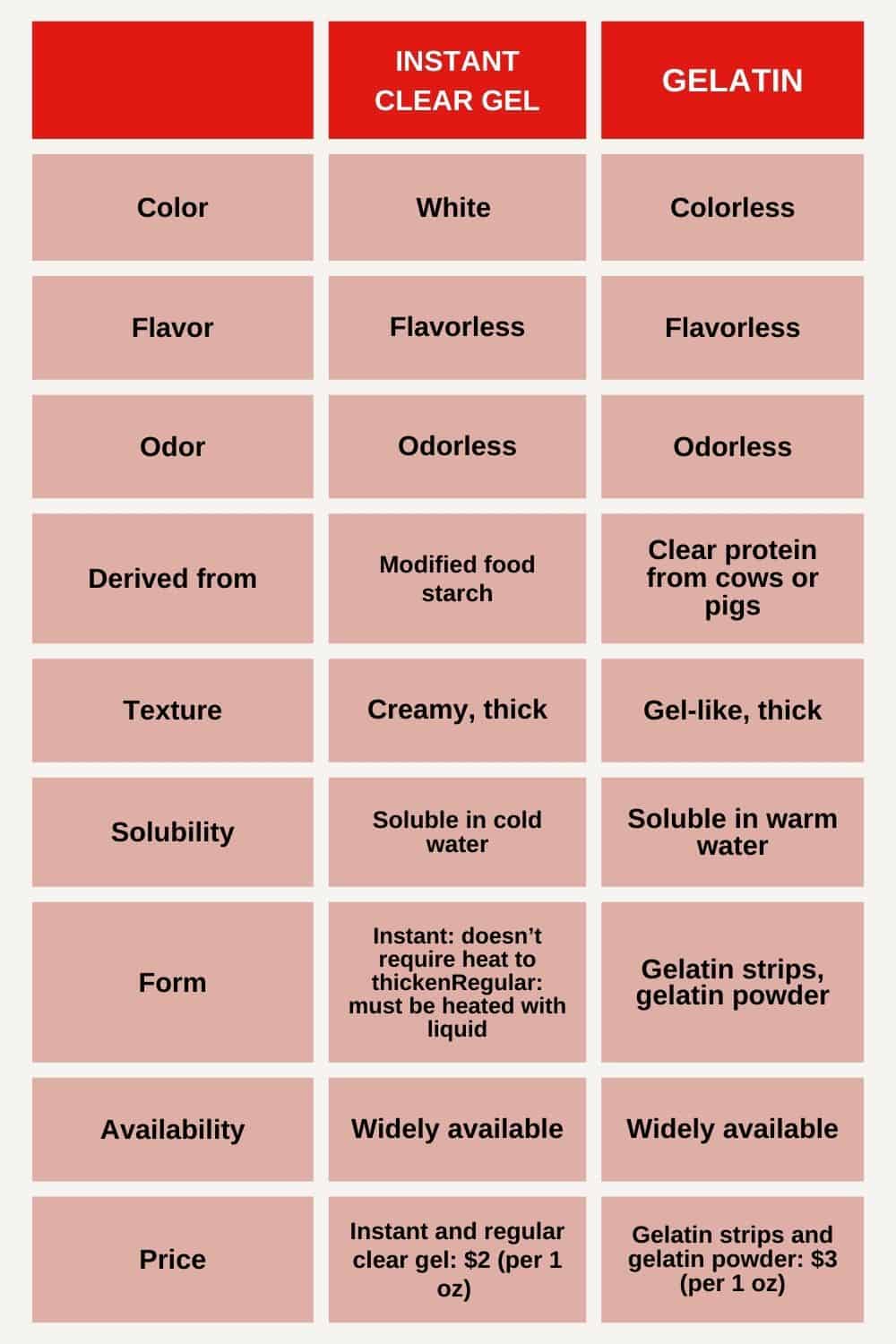
How to use instant clear gel in recipes
Substitute ratio: No recommended substitute ratio. Experimenting needed!
Preparation: Follow the directions provided on the package for instant or regular clear gel version.
Recipes: Instant version is great for no-bake cheesecake and stabilized whipped cream. The regular version is used for fruit pie feelings and sauces.
What Do You Think About These Gelatin Substitutes?
Are you already using some of them? Or have you just found your new favorite?
I have this tendency to regularly switch between gelatin substitutes because I easily get bored of using the same substitute over and over again.
Maybe this has something to do with my quirky personality and restless spirit. Be it as it may, I’m 100% satisfied with every substitute provided on this list. I wish the same for you! 😄
